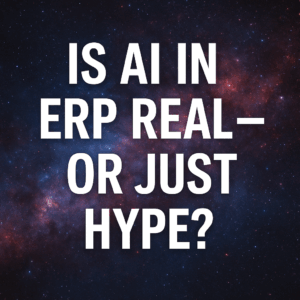The technology industry has been debating whether a single ERP system or a best-of-breed model is better. However, it’s important to determine the best approach for your organization.

As part of our client’s digital transformations, we assess and aid them in implementing Integrated ERP Software. A significant debate that arises is whether to deploy a single ERP system that meets all requirements or to find the best technologies for various business areas and implement a best-of-breed model. In this discussion, we will examine the advantages and disadvantages of each approach and provide a framework to help you choose the best path for your organization.

Table of Contents
ToggleSingle Integrated ERP Software
Let us begin with the single integrated ERP software model. It is the most common starting point for organizations. One of the advantages of a single ERP system is having one system. This leads to other benefits, such as a lower learning curve since users only need to be trained on one system. It is also easier to maintain and deploy since you’re only focused on one system instead of multiple systems for different technologies. Furthermore, it provides a single source of truth for data.
A single ERP system provides the benefit of having all the data stored in one system. This eliminates the concerns of data flow and the possibility of data corruption as it moves between multiple systems. It also reduces technical complexity and maintenance since there is no need to integrate multiple systems and deal with architectural issues that come up due to having multiple systems.
These are some of the advantages and reasons to consider a single integrated ERP software. Let’s now explore the best-of-breed model and compare it with the single ERP system.
Best of Breed
Let’s now discuss the best-of-breed approach. In this model, instead of relying on a single system to fulfill all organizational needs, we opt to select the best technologies for specific parts of the organization. For instance, the accounting and finance team might acquire a finance and accounting system, the supply chain managers may select a supply chain management system, and the sales team may choose a separate customer relationship management or Salesforce automation system. This approach aims to find the best technologies for different departments of the organization, rather than selecting one technology for the entire enterprise.
One benefit of the best-of-breed model is that you’re more likely to find a better fit across the organization. ERP vendors that sell the single ERP software model may argue against this point, but it’s not entirely accurate. Best-of-breed models offer technologies that can handle specific functions better than a single ERP system can. This is because no single ERP software vendor can cater to every need of every business. Even if an ERP vendor focuses on one industry, there could be different nuances in different parts of a business that require different needs, which cannot be fully satisfied by a single ERP model.
In a best-of-breed model, there’s a higher learning curve compared to a single ERP system because you need to train people on how to use multiple systems. One of the potential downsides is that it can result in multiple sources of truth.

In summary, if we have a CRM system tracking our sales pipeline and capturing prospective client information, we are housing customer and prospective customer data in the CRM system. However, we presumably have another system for inventory management or financials where we also need that same customer-related information. Integration is needed between systems, and there’s more potential for something to break down or become undermined as a result of some of the human interactions between systems.
This is a potential disadvantage of the best-of-breed model compared to the singular ERP model, which has one system handling all data, providing a single source of truth, and thus avoiding integration challenges. Best-of-breed also has higher technical complexity because it involves tying multiple systems together and figuring out how to integrate them.
Based on the four categories or criteria outlined, the advantages seem to lean towards the single ERP system model. There are three advantages in favor of single ERP and only one advantage for best of breed, which is the likelihood of finding a better fit.
However, this decision ultimately becomes crucial for most clients. The difference between the two models is significant, and it goes beyond just checking off a list of pros and cons. Functionally, an organization may not be able to effectively handle its operations and meet its requirements, which may push it towards a best of breed model.
In some cases, resistance to the best of breed model may indicate a resistance to change. However, in many organizations, their strategic business needs require the advantages of a single ERP model. Determining which model is best is a challenge for organizations trying to resolve this debate. Are there any other options besides the two models? That will be discussed next.
Two Tier Software Model
There is a third option that many organizations don’t consider, and that is a hybrid model. In this approach, a core single ERP system handles all the core functions of the business, while best-of-breed solutions are used for the more complex or unique aspects of the business or industry. For instance, in a manufacturing organization, the core ERP system could handle financials, basic inventory management, bill of materials, and customer information. But for product lifecycle management, CAD drawings, and engineering processes, bolt-ons would attach to the core ERP system.
This model provides a good middle ground for organizations struggling to choose between the single ERP and best-of-breed models. It’s worth noting that many vendors, such as SAP, Oracle, and Microsoft, have acquired best-of-breed providers to supplement their single-core ERP systems. This enables them to offer a hybrid model to their clients, recognizing that a single ERP system may not be able to meet all of their needs.
Regardless of the model chosen, whether it is a single ERP, best-of-breed, or hybrid, integration and operability are critical. Interoperability and integration refer to how multiple systems can be connected, particularly in the case of a hybrid or best-of-breed approach. We need to have a clear plan for how systems can be linked together and how we can use solution architecture and integration to ensure that they work together. However, this is also important in the single ERP model since many vendors have acquired best-of-breed providers as bolt-ons to their system, which are technically third-party systems. Therefore, interoperability and integration are critical in any digital transformation, particularly in the case of best-of-breed or hybrid.
Which is Best?
The question now is which of these models is best. The answer depends on what an organization is trying to achieve and what its priorities are. If an organization’s top priority is finding the best technical and functional fit for its business processes and needs, and it knows that its business is unique or has a distinct competitive advantage that others in its industry don’t have, then the best-of-breed model may be more suitable.
However, if an organization is younger and doesn’t have established business processes or complex needs yet, a single ERP system may be more appropriate. If an organization falls somewhere in between these two extremes, the hybrid model may be the best fit.
Many client organizations approach us with a request to define a digital strategy that leverages the best single ERP system. While this may be a starting goal, we recognize that we may only achieve 80 percent fit. While this is a reasonable number, we may need to figure out what to do with the remaining 20 percent. We can choose to water down our business processes and let the software dictate how we operate, depending on the process’s strategic importance. Alternatively, we may choose to adopt a hybrid model and find other best-of-breed options that we can bolt onto our ERP system.
These are the decision points that organizations must go through to determine the best fit for their needs. If you are looking to strategize an upcoming transformation or are looking at selecting an ERP system, we would love to give you some insights. Please contact me for more information eric.kimberling@thirdstage-consulting.com





